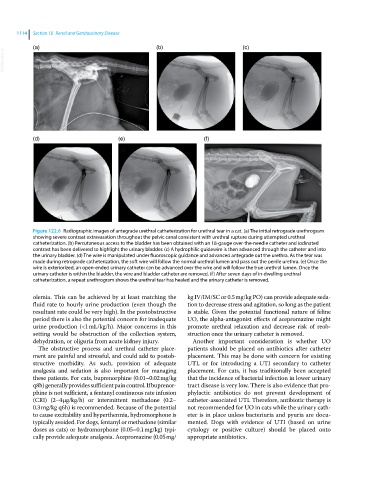Page 1176 - Clinical Small Animal Internal Medicine
P. 1176
1114 Section 10 Renal and Genitourinary Disease
(a) (b) (c)
VetBooks.ir
(d) (e) (f)
Figure 122.6 Radiographic images of antegrade urethral catheterization for urethral tear in a cat. (a) The initial retrograde urethrogram
showing severe contrast extravasation throughout the pelvic canal consistent with urethral rupture during attempted urethral
catheterization. (b) Percutaneous access to the bladder has been obtained with an 18‐gauge over‐the‐needle catheter and iodinated
contrast has been delivered to highlight the urinary bladder. (c) A hydrophilic guidewire is then advanced through the catheter and into
the urinary bladder. (d) The wire is manipulated under fluoroscopic guidance and advanced antegrade out the urethra. As the tear was
made during retrograde catheterization, the soft wire will follow the normal urethral lumen and pass out the penile urethra. (e) Once the
wire is exteriorized, an open-ended urinary catheter can be advanced over the wire and will follow the true urethral lumen. Once the
urinary catheter is within the bladder, the wire and bladder catheter are removed. (f) After seven days of in‐dwelling urethral
catheterization, a repeat urethrogram shows the urethral tear has healed and the urinary catheter is removed.
olemia. This can be achieved by at least matching the kg IV/IM/SC or 0.5 mg/kg PO) can provide adequate seda
fluid rate to hourly urine production (even though the tion to decrease stress and agitation, so long as the patient
resultant rate could be very high). In the postobstructive is stable. Given the potential functional nature of feline
period there is also the potential concern for inadequate UO, the alpha‐antagonist effects of acepromazine might
urine production (<1 mL/kg/h). Major concerns in this promote urethral relaxation and decrease risk of reob
setting would be obstruction of the collection system, struction once the urinary catheter is removed.
dehydration, or oliguria from acute kidney injury. Another important consideration is whether UO
The obstructive process and urethral catheter place patients should be placed on antibiotics after catheter
ment are painful and stressful, and could add to postob placement. This may be done with concern for existing
structive morbidity. As such, provision of adequate UTI, or for introducing a UTI secondary to catheter
analgesia and sedation is also important for managing placement. For cats, it has traditionally been accepted
these patients. For cats, buprenorphine (0.01–0.02 mg/kg that the incidence of bacterial infection in lower urinary
q8h) generally provides sufficient pain control. If buprenor tract disease is very low. There is also evidence that pro
phine is not sufficient, a fentanyl continuous rate infusion phylactic antibiotics do not prevent development of
(CRI) (2–4 μg/kg/h) or intermittent methadone (0.2– catheter‐associated UTI. Therefore, antibiotic therapy is
0.3 mg/kg q6h) is recommended. Because of the potential not recommended for UO in cats while the urinary cath
to cause excitability and hyperthermia, hydromorphone is eter is in place unless bacteriuria and pyuria are docu
typically avoided. For dogs, fentanyl or methadone (similar mented. Dogs with evidence of UTI (based on urine
doses as cats) or hydromorphone (0.05–0.1 mg/kg) typi cytology or positive culture) should be placed onto
cally provide adequate analgesia. Acepromazine (0.05 mg/ appropriate antibiotics.

